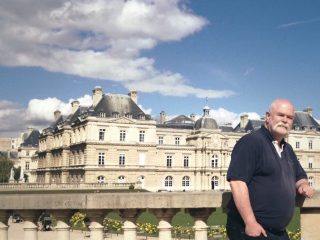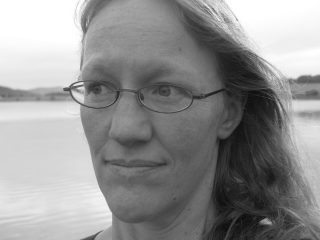
Tansy Davies
Composer Tansy Davies has written several pieces to the oboe and cor anglais repertoire detailed below. Her website is comprehensive and features a number of exciting chamber music compositions that also feature the oboe. Visit www.tansydavies.com for more details.
Aquatic
This piece was born of a fascination for the amazing creatures, preserved as fossils, in the Burgess Shale Formation – located in the Canadian Rockies of British Columbia. Many of the animals had bizarre anatomical features and only the slightest resemblance to other known animals. One example is Opabinia, which has five eyes and a snout like a vacuum cleaner hose, probably lived on the seafloor, had no legs but crawled on lobes, and could also have swum slowly by flapping the lobes, especially if it timed the movements to create “Mexican waves”.
Aquatic is perhaps a ‘day in the life of an Opabinia’. There’s an exotic elegance and grace about this strange animal, for which the Cor seems the perfect counterpart. The percussion pallet surrounds and echoes the Cor Anglais, imagining the submerged environment of the early-Cambrian seafloor.
Aquatic was first performed 11th April 2001 at Kings Place, London, by Janey Miller and Joby Burgess.
Forgotten Game 2
Forgotten Game 2 is a kind of meditation on nature, in a pagan or spiritual sense. Here the oboist plays the role of a faun accompanying the growth of a tree. The faun weaves a ‘power web’ from the roots to the canopy of the tree. The web precedes the tree’s growth: the faun chooses the direction of the growth and thus the shape of the tree.
It was first performed 17th September 2009 by Nicholas Daniel and Katya Apekisheva at Leicester International Music Festival.

Arabescos
Arabescos was composed after a visit to the Alhambra in Granada, Spain. As a pattern maker myself – much of my music consists of patterns – I was enthused and inspired by the intricacy and beauty of the patterns and designs, and stunned at the scale of it all.
Throughout the piece short phrases are spun into long lines, through variation and repetition: melodies evolve as musical cells twist and turn, forming recognisable shapes and patterns. These lines, which are mostly heard on the oboe, grow into contrasting paragraphs with different moods. And while the he oboe is clearly the soloist here, the piano provides an ever-changing backdrop, but occasionally explodes onto centre stage.
Arabescos was first performed 6th July 2002 by Nicholas Daniel and Julius Drake at the Pitville Pump Room, Cheltenham.

About Tansy Davies
Born in Bristol, she studied both horn and composition at the Colchester Institute and subsequently spent three years as a freelance horn player before further study at the Guildhall School of Music & Drama with Simon Bainbridge and at Royal Holloway with Simon Holt. Davies’s success in the 1996 BBC Young Composer workshops in Manchester led to her first commissions from the Composers Ensemble, the Brunel Ensemble and the London Sinfonietta, giving her music wide exposure in concerts, broadcasts and recordings.
Written in 2004, neon, for chamber ensemble has become for many the signature Tansy Davies work, with its gritty, sleazy sounds and pounding rhythms. The frequent performances and two commercial recordings attest to the work’s popularity, and alongside similarly obsessive chamber works such as saltbox (2005) and the suggestively titled grind show (2007) it can be tempting to hear these qualities of obsession and sometimes degraded instrumental sounds as the dominant characteristic of her music. It is certainly these elements, plus an enthusiasm for Prince, that have until recently made the best copy for interviews. But while the more brazen elements of Davies’s style are certainly present in her Zaha Hadid-inspired trumpet concerto Spiral House (2004) and the LSO commission Tilting (2005), what has become increasingly apparent is the contemplative, even meditative nature of Tansy Davies’s music – which is in no way paradoxical to the ferocity her music can attain.
A pivotal work is Falling Angel, written for Thomas Adès and BCMG and first performed in Birmingham and then in Paris, at the Présences festival in 2007. Almost a rondo, the music alternates several highly energised musical images that eventually yield to a passage of sustained cantabile writing – unique in Davies’s music at the time. It was shortly after this that she began to write her first works for voice and these now mark out a distinctive aspect of her work, whether in the mesmeric song cycle Troubairitz (2010) or the snow-blinded brightness of Christmas Eve written for the 2011 Festival of Nine Lessons and Carols at King’s College, Cambridge.
It is music that sings or is sung which has come to dominate Tansy Davies work in the last five years, from the tender As with Voices and with Tears – a Whitman setting commemorating the dead of the First World War – to the orchestral Wild Card (2010) and the piano concerto Nature (2012). Wild Card is a ritualistic exploration of the world of the Tarot and, in its implicit confrontation with the idea of destiny, it forms a bridge to Davies’s opera Between Worlds, commissioned by ENO and the Barbican. Presided over by the figure of a Shaman, symbolising every aspect of the opera’s creation, both overt and occult (in all senses), Between Worlds is a meditation on the events of 9/11 and a work that is for Tansy Davies both summatory and a new beginning.
Listed in the Evening Standard’s Progress 1000 of the UK’s most influential people of 2015, Davies’s current projects include a large-scale work for symphony orchestra.



